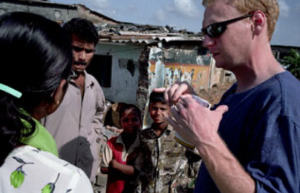By Andrew Strickler, for the San Francisco Chronicle (class of 2005)
MUMBAI, India, November 12, 2004—On a muggy evening, Dipak Gandhi stood on a pedestrian walkway at Andheri Station, watching throngs of commuters push in and out of jam-packed cars on India’s most congested suburban railway.
“People go mad,” said Gandhi, president of the Bombay Suburban Passengers’ Association, an 800-member organization he founded in 1980 to lobby railway officials for improvements. “Every day, this is their ritual. Or should I say their punishment?”
Bombay, also known as Mumbai, is a city of 16 million inhabitants, of whom 6 million ride the city’s three main lines daily — more riders than all of New York City’s subways, buses, trains and ferries combined. Trains designed to hold 1,700 passengers carry as many as 4,700 during peak hours in a bone-crushing 1.4 bodies per square foot of space.
As a result, some 3,500 passengers, or 10 a day, are killed annually in grisly accidents. Some are crushed to death by fellow riders or under speeding trains after falling out of doors that are typically left open to accommodate more riders. Others are killed by moving trains while crossing tracks to avoid crowded pedestrian walkways.
Bombay’s trains are a far cry from New Delhi’s new $1.5 billion futuristic cars. Passengers in the capital use smart cards or smart tokens to ride the spotlessly clean Delhi Rail Metro, which will open the city’s first underground rail link next month.
But in Bombay, most commuters have little choice but to use the 79-year- old train system. Because Bombay streets are typically clogged during peak hours, trains are the only way to get home or to work on time.
…
Read the rest of the story, published in the San Francisco Chronicle


